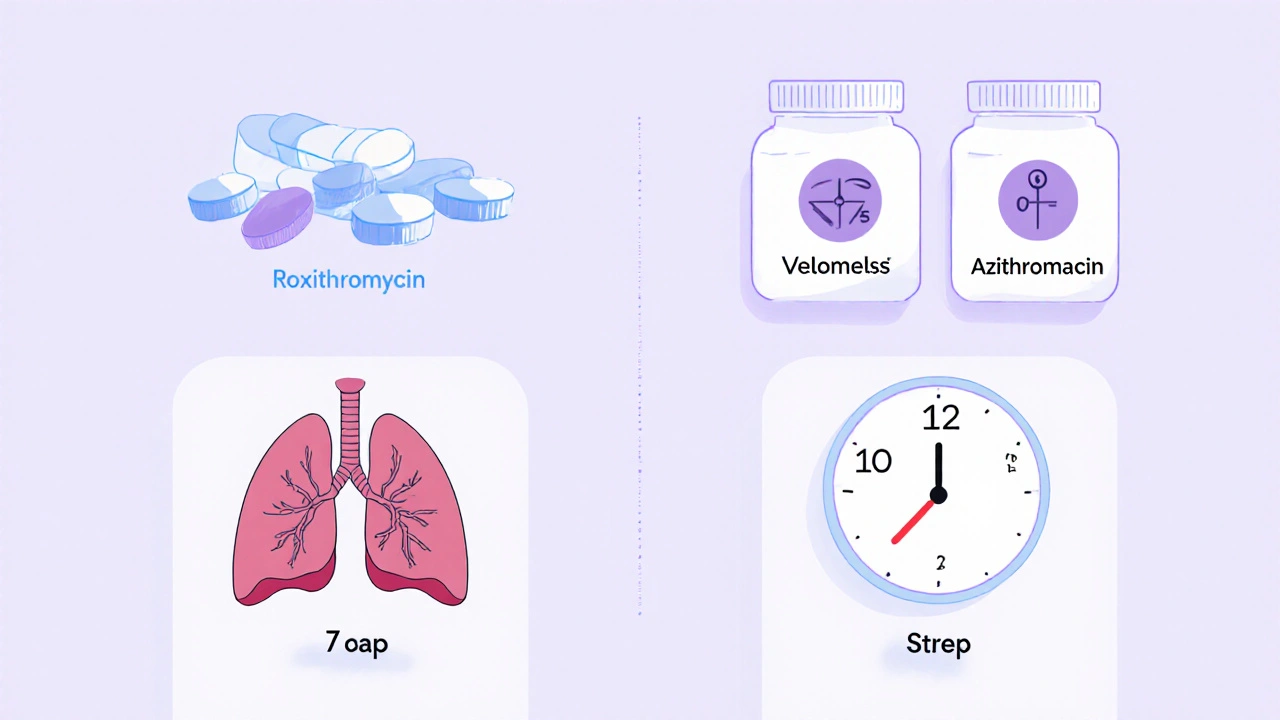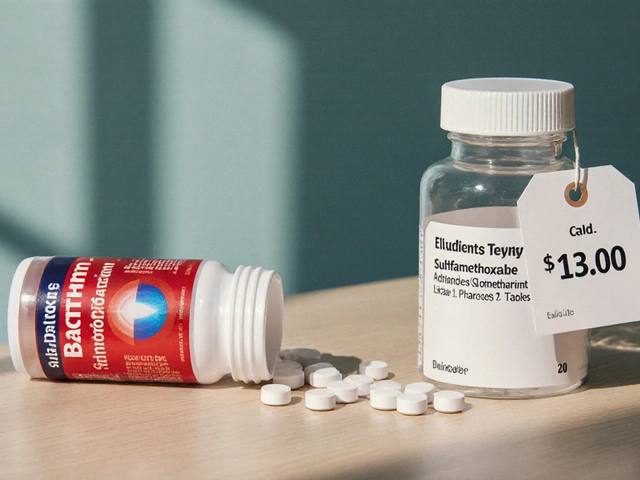Antibiotic Selection Guide
Select Your Situation
This tool helps you understand which antibiotics might be appropriate for your situation based on the information in the article.
Recommended Antibiotics
When you’re prescribed an antibiotic, you don’t always get a choice - but you should understand what you’re taking. Roxithromycin is one of those less commonly discussed macrolide antibiotics that still shows up in prescriptions, especially for respiratory and skin infections. But is it the best option? How does it stack up against more familiar names like azithromycin, clarithromycin, or even amoxicillin? Let’s break it down plainly, without the jargon.
What is roxithromycin, really?
Roxithromycin is a second-generation macrolide antibiotic. That means it’s a cousin to erythromycin, but with better absorption and fewer stomach issues. It works by stopping bacteria from making proteins they need to survive. It’s effective against common bugs like Streptococcus pneumoniae, Haemophilus influenzae, and some strains of Mycoplasma and Chlamydia.
It’s often used for:
- Strep throat and tonsillitis
- Sinus infections
- Bronchitis
- Early-stage pneumonia
- Some skin and soft tissue infections
Unlike penicillin-based drugs, it’s safe for people with penicillin allergies - which is a big reason doctors reach for it. But it’s not a magic bullet. It doesn’t work against every infection, and resistance is growing.
Roxithromycin vs. azithromycin: the most common comparison
Azithromycin (Zithromax) is probably the most well-known macrolide these days. It’s the one you get as a 5-day Z-Pak. So how does roxithromycin compare?
| Feature | Roxithromycin | Azithromycin |
|---|---|---|
| Typical dose | 150 mg twice daily for 7-14 days | 500 mg once daily for 3-5 days |
| Half-life | 8-12 hours | 68 hours |
| Food interaction | Absorption drops with food - take on empty stomach | Can be taken with or without food |
| Best for | Respiratory infections, mild pneumonia | STIs, bronchitis, short-course therapy |
| GI side effects | Moderate (nausea, diarrhea) | Lower risk |
| Drug interactions | Higher risk with statins, warfarin | Lower interaction profile |
Azithromycin wins on convenience - fewer pills, fewer days. Roxithromycin has slightly better tissue penetration in the lungs, which might matter for deeper respiratory infections. But for most people, azithromycin’s simplicity makes it the go-to.
Roxithromycin vs. clarithromycin: which is stronger?
Clarithromycin (Biaxin) is another close relative. It’s often used for H. pylori (stomach ulcers) and more severe lung infections. Here’s how they differ:
- Clarithromycin is more potent against H. pylori and some drug-resistant strains. It’s often paired with proton pump inhibitors and amoxicillin in triple therapy.
- Roxithromycin is less likely to interfere with liver enzymes, meaning fewer interactions with blood thinners or cholesterol meds.
- Clarithromycin has a longer half-life (3-7 hours vs. roxithromycin’s 8-12), but it’s dosed twice daily too.
- Both can cause taste disturbances - but clarithromycin is more likely to.
If you have a stomach ulcer or a stubborn sinus infection that didn’t respond to first-line treatment, clarithromycin might be preferred. For straightforward throat or lung infections, roxithromycin is still a solid pick.
Roxithromycin vs. amoxicillin: the penicillin alternative
Amoxicillin is the most common antibiotic worldwide. It’s cheap, effective, and safe. So why would a doctor choose roxithromycin instead?
The answer is usually one thing: allergy.
If you’re allergic to penicillin - even a mild rash - amoxicillin is off the table. That’s where roxithromycin steps in. It’s not as broad-spectrum as amoxicillin, though. Amoxicillin covers more types of bacteria, including some that cause ear infections and urinary tract infections. Roxithromycin doesn’t touch those.
Also, resistance is a bigger problem with amoxicillin. In many regions, over 30% of strep throat cases are now resistant to amoxicillin. Roxithromycin still works in many of those cases.
Bottom line: Amoxicillin is first-line for most infections. Roxithromycin is the backup when penicillin isn’t an option.
Other alternatives: doxycycline, cefdinir, levofloxacin
There are other options that aren’t macrolides but are often used when macrolides fail or aren’t suitable:
- Doxycycline: A tetracycline. Good for atypical pneumonia (like mycoplasma), tick-borne illnesses, and acne. Not for kids under 8 or pregnant women.
- Cefdinir: A cephalosporin. Similar spectrum to amoxicillin but safe for penicillin allergies (in most cases). Often used for ear infections and sinusitis.
- Levofloxacin: A fluoroquinolone. Powerful, but reserved for serious infections due to risk of tendon damage and nerve issues. Not for simple throat infections.
These aren’t direct replacements for roxithromycin - they’re for different scenarios. But if roxithromycin doesn’t work after 48-72 hours, your doctor might switch to one of these.
When roxithromycin might not be right for you
It’s not a one-size-fits-all drug. Avoid roxithromycin if:
- You’ve had liver problems - it’s processed by the liver and can raise liver enzymes.
- You’re on blood thinners like warfarin - it can increase bleeding risk.
- You have a history of heart rhythm issues (QT prolongation) - macrolides can worsen this.
- You’re taking certain statins (like simvastatin) - risk of muscle damage.
Also, it’s not used for urinary tract infections, most skin abscesses, or gastrointestinal infections. Don’t assume it works for everything just because it’s an antibiotic.

Real-world advice: what to ask your doctor
If you’re prescribed roxithromycin, here are three smart questions to ask:
- Why this one instead of azithromycin or amoxicillin?
- Is there a chance this won’t work because of resistance in my area?
- What should I do if I don’t feel better in 2-3 days?
Doctors don’t always explain the reasoning - but they should. If they don’t, ask. You’re not being difficult. You’re being informed.
What about side effects?
All antibiotics cause side effects. Roxithromycin’s most common are:
- Nausea (30% of users)
- Diarrhea (15-20%)
- Headache (10%)
- Abdominal pain
Less common but serious:
- Liver inflammation (yellow skin, dark urine - stop and call your doctor)
- Severe allergic reaction (rash, swelling, trouble breathing)
- Heart rhythm changes (dizziness, palpitations)
Take it on an empty stomach - at least 15 minutes before eating. Food cuts absorption by up to 40%. Don’t skip meals just to take the pill, but time it right.
Final verdict: when roxithromycin makes sense
There’s no single "best" antibiotic. It depends on your infection, your allergies, your other meds, and local resistance patterns.
Roxithromycin is a good choice if:
- You’re allergic to penicillin
- You need a respiratory antibiotic and can’t take azithromycin for some reason
- You’re in an area where strep throat is resistant to amoxicillin
- Your doctor knows your full medical history and has ruled out contraindications
It’s not the best if:
- You want the simplest, shortest course
- You’re on multiple other medications
- Your infection might be bacterial but not covered by macrolides
Antibiotics aren’t interchangeable. They’re tools - each designed for specific jobs. Roxithromycin isn’t the most popular, but it’s still a reliable one when used correctly.
Is roxithromycin stronger than amoxicillin?
No, roxithromycin isn’t stronger - it’s just different. Amoxicillin covers a wider range of bacteria, including many common ones that cause ear infections and UTIs. Roxithromycin is narrower but works well against certain respiratory bugs, especially when penicillin resistance is high. Strength isn’t the issue - spectrum and safety are.
Can I take roxithromycin if I’m allergic to penicillin?
Yes, roxithromycin is a safe alternative for people with penicillin allergies. It belongs to a different antibiotic class (macrolide), so cross-reactivity is extremely rare. But always tell your doctor about any past reactions, even if they were mild.
How long does it take for roxithromycin to start working?
Most people start feeling better within 2-3 days. If you don’t notice improvement by day 3, or if symptoms get worse, contact your doctor. Don’t wait until the full course is done - some infections need a faster switch.
Can I drink alcohol while taking roxithromycin?
Alcohol doesn’t directly interact with roxithromycin, but it can worsen side effects like nausea and dizziness. It also stresses your liver - and roxithromycin is processed there. Best to avoid alcohol until you’re done with the course and feeling fully recovered.
Is roxithromycin still used in Canada and the US?
It’s available but not first-line in North America. Azithromycin and amoxicillin are more common because they’re cheaper and easier to use. Roxithromycin is more frequently prescribed in Europe and parts of Asia. In Canada and the U.S., it’s usually reserved for penicillin-allergic patients or when other options fail.








Sam Reicks November 19, 2025
roxithromycin is just a big pharma scam to sell you pills you dont need theyve been pushing macrolides since the 90s while real cures like herbal antimicrobials get banned
Chuck Coffer November 21, 2025
Of course you're telling people to ask their doctor. Because that's never been a problem before. Sure. Next you'll tell me the moon landing was real.
Andrew Baggley November 21, 2025
Really appreciate this breakdown. So many people treat antibiotics like candy but this shows how nuanced it actually is. Roxithromycin isn't flashy but it's got a solid niche - especially for penicillin-allergic folks who need something that actually works on stubborn respiratory bugs. Don't sleep on it just because it's not on TV ads.
Frank Dahlmeyer November 23, 2025
Let me tell you something - antibiotics are not just about killing bacteria, they're about respecting the delicate ecosystem inside your body. Roxithromycin, while not the most popular, has a quiet elegance to it. It doesn't go on a rampage like amoxicillin, it doesn't hog the spotlight like azithromycin. It just quietly does its job in the lungs, where it matters most. And for that, it deserves more respect. We've forgotten how to appreciate subtlety in medicine.
Codie Wagers November 23, 2025
It's fascinating how society treats medical knowledge as a commodity rather than a responsibility. The fact that you need to ask your doctor why they prescribed roxithromycin reveals a systemic failure - patients are being treated as passive recipients, not participants in their own health. This isn't empowerment, it's negligence dressed up as autonomy.
Paige Lund November 24, 2025
So... I take this on an empty stomach? Cool. I'll just skip breakfast then. /s
Reema Al-Zaheri November 25, 2025
Thank you for the detailed comparison. I’ve been prescribed roxithromycin twice for recurrent sinusitis, and I’ve noticed that taking it exactly 30 minutes before meals makes a significant difference in tolerability. Also, in India, it’s more commonly prescribed than azithromycin due to local resistance patterns - especially in urban clinics. The 150 mg twice-daily regimen, while less convenient, often yields better clinical outcomes in chronic cases.
Michael Salmon November 25, 2025
Stop glorifying roxithromycin. It’s a second-rate drug with more drug interactions than a college student’s pill organizer. If you’re not allergic to penicillin, you’re wasting your time with this. Amoxicillin is cheaper, better studied, and doesn’t turn your liver into a cautionary tale. This whole post reads like a pharmaceutical sales pitch disguised as medical advice.
Joe Durham November 26, 2025
I think everyone here is missing the point - it’s not about which antibiotic is ‘best.’ It’s about matching the tool to the job, and respecting that what works for one person might be dangerous for another. I had a friend who went into anaphylaxis on amoxicillin, and roxithromycin saved her life. But for me, it gave me stomach cramps for a week. There’s no universal winner here. Just good doctors who listen.